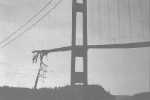
Over the last few years it has become clear that if you begin with a homogenous substrate, like the Internet with it’s peer to peer architecture, what emerges is a network with a power-law distribution. I.e. there is an entirely natural mindless meritless mathematics that drives level playing fields toward terrible unequal outcomes.
In turn that makes it clear that thinking about the topology of the networks that a platform enable is the the key challenge facing designers in this generation.
That if we want to maintain some degree of equality as the world captures the benefits of one vast uniform platform for communications and trade we are going to have to mighty careful.
One extreme topological form in this design space is the bridge, or two sided network. For example eBay is a bridge between buyers and sellers. The village marketplace was the old example of this. Google, another example, bridges between searchers to those that wish to be found. The yellow pages was the old example of that. Platform vendors, a final example, bridge from diverse hardware to diverse applications.
The power-law distributions emerge because some players in the network become hubs; and a few of these hubs become very very large. I suspect that the bridge topology is only one way that a hub can function – it’s a design that helps the hub manage both to scale and to remain durable. I yearn to see if there are others kinds hubs – for example is there one that is analagous to the train yard.
In anycase I was amused by this paragraph about this cool tool that visualizes social networks.
LJNet puts social networking on crack – but this might actually have some negative side effects. My primary concern is worsening the potential social side-effects of ‘bridge-collapsing’ – allowing my friends to connect to other friends of mine without going through me as a bridge, a moderator, a contextualizer, etc can have some unpleasant side effects. Thus I’m considering a password-protected version of the LJNet system that only allows users to see their own networks, and to anonymize the 2nd degree friend nodes so that if I see that my friend has another friend with many interests in common with me, I’ll have to ask my friend to meet this person. Of course this wouldn’t be fool-proof, but this is my other concern before releasing it publicly.
Most people think the middleman is a somewhat dubious role; i.e. the whole problem of agency. But, what about the risks of “bridge collapse?”
good